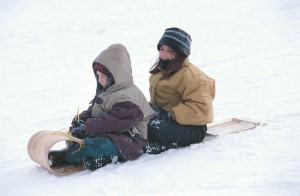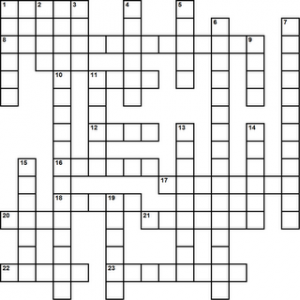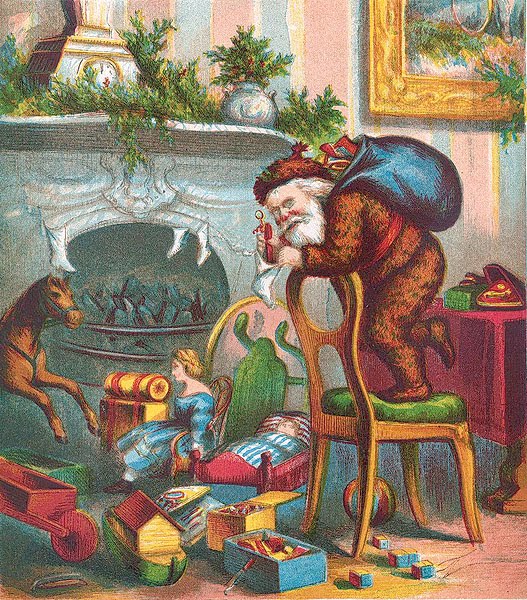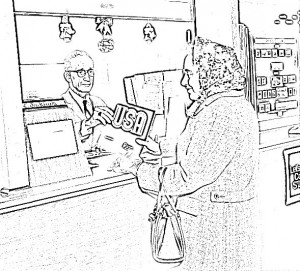1. In what place are these two people?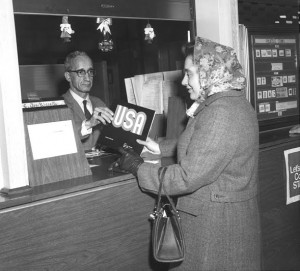
They are in the post office.
2. Where is the man standing?
He is standing behind the counter (behind the window).
3. What is he doing?
He is handing the woman a small packet.
4. Where is the woman standing?
The woman is standing at the counter (at the window).
5. What is the woman doing?
She is taking the packet from the man.
6. Why might the woman have gone to the post office?
She may have gone to the post office to buy some stamps.
7. What kinds of things may be bought at the post office?
At the post office, a person can buy stamps, envelopes, boxes, padded envelopes, tape, and other mailing supplies.
8. What can people do at the post office besides buy stamps and other mailing supplies?
People can pick up their mail from the post office. They can mail a letter or parcel. They can have letters and packages weighed. They can get official government forms, like passport applications and tax forms.
9. Are there other people also at the post office?
We don’t see any other people at this post office.
10. What do you do if there are other people waiting in line?
If there are other people waiting in line, you have to wait for your turn.
11. What can the man behind the window do if he has to do something in back?
If he has some task to do in the back of the post office, he can put a sign at his window.
12. What would the sign say?
The sign would say “Next Window Please” or “Will Be Back Soon.”
13. On what days is the post office open?
The post office is open from Mondays through Saturdays. It is closed on Sundays.
14. When does the post office open?
The post office usually opens at 8 a.m. or 8:30 a.m.
15. When does the post office close?
The post office usually closes at 5 p.m. On Saturdays, it usually closes at 12 noon, or 12:30 p.m.
16. On what holidays does the post office close?
In the US, the post office is closed on federal holidays: New Year’s Day, Martin Luther King Jr’s Birthday, Washington’s Birthday (President’s Day), Memorial Day, Independence Day, Labor Day, Columbus Day, Veterans Day, Thanksgiving Day, and Christmas Day.
17. What is the name of the person who delivers the mail?
The person who delivers the mail is called a mailman, a postman, a mail lady, or a mail carrier. Other people who work for the post office can be called postal workers. The head of the local post office is called a postmaster.
18. What happens to the mail of a person who has moved to a new house or apartment?
If a person has moved, his mail will be forwarded if he has filled out a “change of address” form. If he has not filled out a change of address form, it will be marked “undeliverable” and returned to sender.
19. What happens to the mail of a person who is on vacation?
If a person goes on vacation, he can request that his mail be held until he returns from vacation. He can then go to the post office and pick it up. To have his mail held, he must fill out an “authorization to hold mail” form.
20. How is international mail usually sent?
International mail is usually sent via airmail.
21. What kind of hobby do some people have with stamps?
Some people collect stamps for a hobby.
Paragraph: At the Post Office
Write a brief paragraph about the last time you had to go to the post office for something. What did you do there? Were there other people there too? What are some other reasons why you usually go to the post office?
Just before Christmas, I had to go to the post office to buy some stamps. I had to mail my Christmas cards, and I wanted to get the special Christmas stamps available at the post office. The Christmas stamps came out in October, and came in two sets. One design had Madonna and Child (the Virgin Mary and Baby Jesus). The other set had four different designs: a reindeer, a snowman, a gingerbread man, and a nutcracker. Each set comes in a booklet containing 20 stamps. The stamps have self-sticking adhesive on the back, so they do not need to be licked.
There were a few people already waiting in line at the post office. Some people had Christmas cards and Christmas packages that they wanted to mail. The packages had to be weighed before the proper postage could be put on the package. People mailing packages had to tell the postal worker if there was anything breakable, perishable, or hazardous. They also had to fill out a form if they wanted to have the package insured.
Some people came to the post office to pick up their mail from their post office box. Some people came to the post office to buy some boxes or other mailing supplies for their Christmas packages. Some people were planning on going somewhere for Christmas vacation, so they filled out a form to have their mail held until they came back.
In the lobby of the post office, there is also a bulletin board with some “wanted posters” on it. If there are dangerous fugitives that are wanted by the FBI, the local post office will have their pictures put up on a wanted poster. The people on the wanted poster do not look like they are very nice people. I hope that I never seen them walking down the street somewhere.
Google
